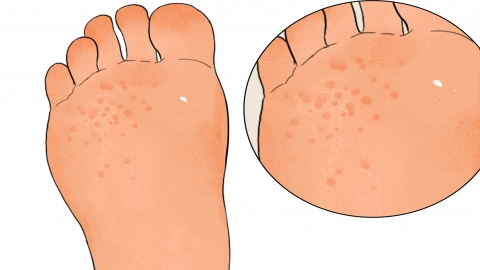What causes small, itchy blisters on the feet?
Generally, small blisters on the feet accompanied by itching may be caused by prolonged exposure to a damp environment, friction irritation, insect bite dermatitis, tinea pedis (athlete's foot), eczema, and other conditions. Prompt medical consultation is recommended for diagnosis and treatment according to medical advice. Details are as follows:

1. Prolonged Damp Environment: Extended exposure of the feet to damp conditions may damage the skin's barrier function, promoting microbial growth such as fungi and bacteria, which can lead to inflammatory reactions manifesting as blisters and itching. It is recommended to wash the feet daily with warm water and a mild soap, especially between the toes, to remove dirt and bacteria.
2. Friction Irritation: Friction between the feet and shoes or socks may damage the skin, triggering an inflammatory response that results in blister formation and itching. It is advised to wear well-fitting, soft-material shoes and socks to avoid tight or coarse fabrics that may cause irritation.
3. Insect Bite Dermatitis: Insect saliva contains acidic substances that can cause allergic reactions upon biting, leading to symptoms such as blisters, itching, and possibly swelling. Treatment may include topical application of mupirocin ointment, erythromycin ointment, or halometasone cream as directed by a physician to relieve inflammation and itching.
4. Tinea Pedis (Athlete's Foot): Caused by dermatophyte infections such as Trichophyton rubrum or Trichophyton mentagrophytes, these fungi are primarily transmitted through direct or indirect contact—for example, sharing slippers or foot basins with infected individuals. Fungal irritation of the foot skin can cause symptoms such as itching, blisters, and possibly foot odor. Antifungal treatments like amorolfine hydrochloride cream, luliconazole cream, or itraconazole capsules may be used under medical guidance.
5. Eczema: Both intrinsic factors (such as genetic predisposition, immune dysfunction, and endocrine imbalances) and extrinsic factors (including allergen exposure, damp environments, and friction irritation) can trigger eczema. Eczema leads to inflammatory cell infiltration and release of inflammatory mediators, causing symptoms such as blisters and itching, which may also be accompanied by erythema (redness). Treatments such as desonide cream, hydrocortisone cream, or sulfur ointment may be used as directed by a physician to reduce inflammation and alleviate itching.
During treatment, appropriate measures should be taken according to the specific cause, along with maintaining foot hygiene and dryness and avoiding friction or irritation as part of daily care.
References:
1. Zhang Xuejun. Dermatology and Venereology [M]. 9th edition. Beijing: People's Medical Publishing House, 2018.









